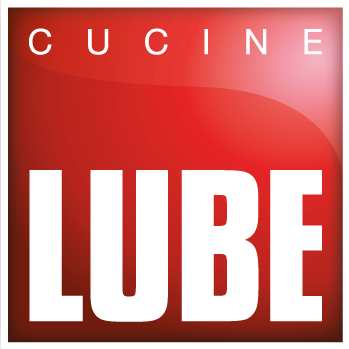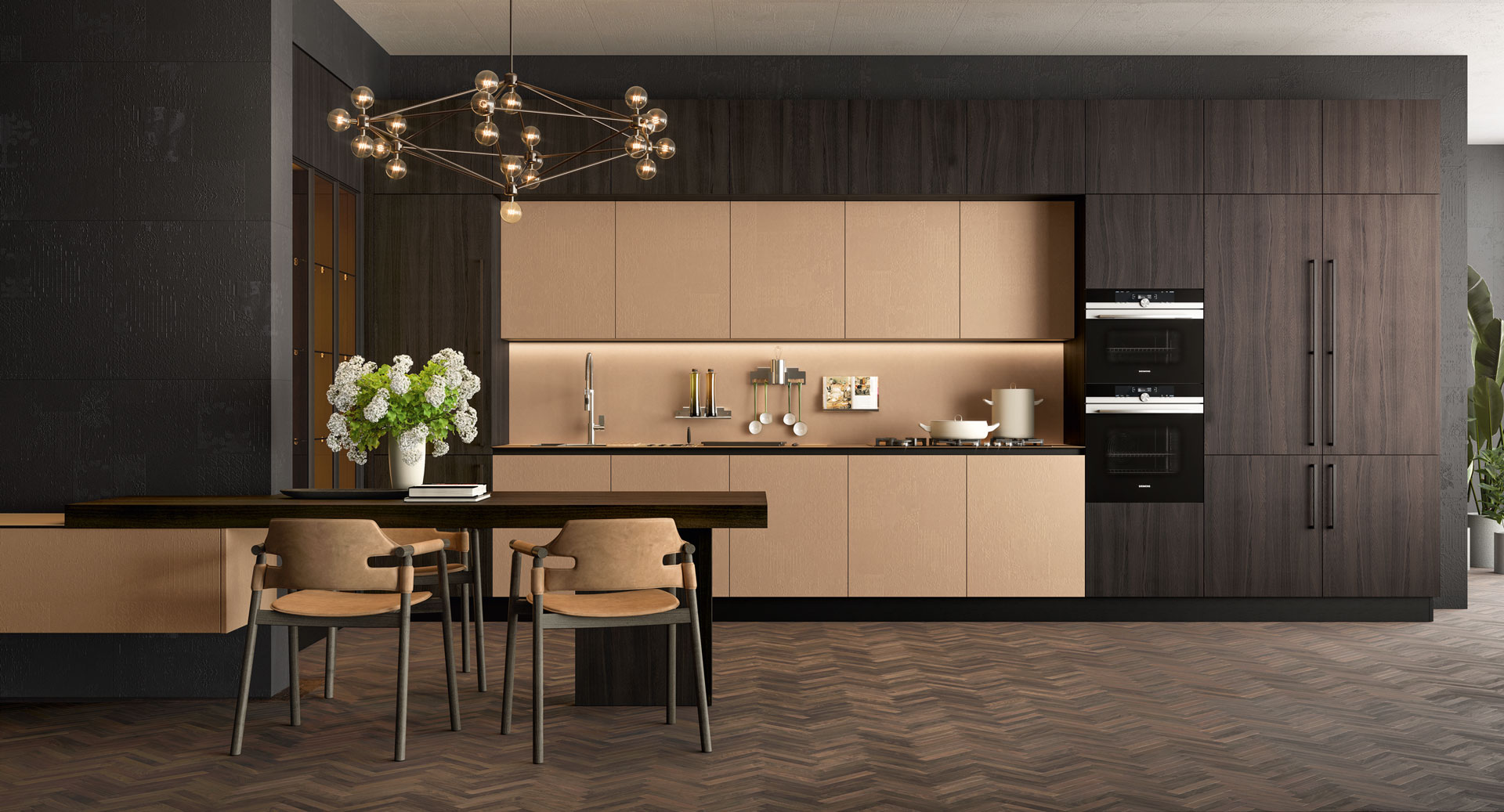

LUBE INDUSTRIES Srl Via dell’Industria, 4 - Treia (MC) - Italy
Kitchen cabinets, CLOVER BRIDGE model.

This product data sheet complies with the specifications set out by Italian Legislative Decree no. 206 dated 6th September 2005 "Consumer Code".
Door consisting of a chipboard panel support (conforming to E1 and US EPA TSCA Title VI), 22 mm thick, veneered in horizontal-grain European oak and trimmed on 4 sides in solid oak, 1 mm thick, or with longitudinal grain; all glued with polyurethane adhesives. The outside is open-pore. Available in various colours.
Frontal, recessed or applied at the top. In aluminium or zamak alloy with various galvanic bath finishes.
Door consisting of a chipboard panel support (conforming to E1 and US EPA TSCA Title VI), 22 mm thick, veneered in vertical-grain European oak with knots and trimmed on 4 sides in brushed, solid oak, 1 mm thick with top-grain for width sides and longitudinal-grain for height sides; all glued with polyurethane adhesives. The outside is open-pore. Available in various colours.
Frontal, recessed or applied at the top. In aluminium or zamak alloy with various galvanic bath finishes.
Door consisting of a chipboard panel support (conforming to E1 and US EPA TSCA Title VI), 22 mm thick, veneered without knots and with semi-open pore, with vertical grain, and trimmed on 4 sides in solid oak, 1 mm thick, smoothed with longitudinal grain; all glued with polyurethane adhesives. Available in various colours.
As doors.
Frontal, recessed or applied at the top. In aluminium or zamak alloy with various galvanic bath finishes.
22 mm thick door consisting of a medium-density fibre panel support (MDF) with cement base, lacquered with pigmented scratch-resistant matt acrylic finish.
As doors.
Frontal, recessed or applied at the top. In aluminium or zamak alloy with various galvanic bath finishes.
22 mm thick door consisting of a medium-density fibre panel support (MDF), faced and lacquered with white polyester resin-based primer and painted with polyurethane paint catalysed with non-yellowing isocyanate (lacquered finishes free from chrome, lead and cadmium). The finish has a brushed, glossy effect, available in various, cold and warm colours.
Frontal, recessed or applied at the top. In aluminium or zamak alloy with various galvanic bath finishes.
22 mm thick door consisting of a medium-density fibre panel support (MDF), faced and lacquered with white polyester resin-based primer and painted with polyurethane paint catalysed with non-yellowing isocyanate (lacquered finishes free from chrome, lead and cadmium). The finish has a soft, matt effect, available in various, cold and warm colours.
As doors.
Frontal, recessed or applied at the top. In aluminium or zamak alloy with various galvanic bath finishes.
22 mm thick door consisting of a medium-density fibre panel support (MDF), lacquered with white polyester resin-based primer and painted with polyurethane paint catalysed with non-yellowing isocyanate (lacquered finishes free from chrome, lead and cadmium). The finish has a semi-gloss vintage metal effect in various colours.
As doors.
Frontal, recessed or applied at the top. In aluminium or zamak alloy with various galvanic bath finishes.
22 mm thick door consisting of a medium-density fibre panel support (MDF), pantographed in bas relief and lacquered. The finish has a “soft”, matt effect, available in various, cold and warm colours.
As doors.
Without handle. PUSH-PULL opening.
The frame is an extruded aluminium profile, 22 mm thick, with matt finish powder coating, honeycomb in the rear part with an ash grey HDF panel. A 3 mm-thick slab of Laminam porcelain stoneware is glued to the front in various colours.
As doors.
Handle built into the door.
The frame is an extruded aluminium profile, 22 mm thick, with powder coating, honeycomb in the rear part with an ash grey HDF panel, 3 mm thick. A bright, 4 mm thick, extra-clear, smooth or satin-finish tempered glass pane is glued to the front.
As doors.
Handle built into the door.
22 mm thick door consisting of a medium-density fibre panel support (MDF), matt lacquered with abstract, textured relief decoration processed with matt polyurethane colours.
Without handle. PUSH-PULL opening.
The frame is an extruded profile in aluminium, 22 mm thick, anodised. A satin or bronze 4 mm thick pane of tempered glass is introduced inside it.
Handle built into the door.
Door consisting of a panel, 22 mm thick in certified MDF (conforming to the US regulations: CARB ATCM PHASE 2 and EPA TSCA TITLE VI), lacquered in oxidised liquid metal: this is a craft product, which is produced with cold rolling through the application of liquid metal (brass and copper), on which special reagents are oxidised, then protected with a specific application for metals. Metals are live elements and the chemical corrosion procedure causes a more or less significant effect which cannot be considered a defect. Available in various colours.
Door consisting of a panel, 22 mm thick in certified MDF (conforming to the US regulations: CARB ATCM PHASE 2 and EPA TSCA TITLE VI), lacquered with semi-gloss oxidised metal effect: this is a craft product, which is produced with a lacquering process followed by manual tamponade to replicate an oxidised effect. This process causes a more or less significant effect which cannot be considered a defect. Available in various colours.
Door consisting of a panel, 22 mm thick in certified MDF (conforming to the US regulations: CARB ATCM PHASE 2 and EPA TSCA TITLE VI), lacquered with marble effect: for this type of door the eighteenth century marble effect technique is used. For the first process on the door in MDF, a watery mortar is spread to create the textured effect of the product and then a skim plaster is applied manually. At this point, it is subjected to a water-based paint cycle (white or light grey) and the manual reproduction of the marble vein on the planar side and on the edge of the door. When these phases have been completed and sufficient time has been given for drying, various coats of transparent acrylic are applied in order to protect the door against dirt and grease infiltration. Available in various colours.
Door consisting of a panel, 22 mm thick in certified MDF (conforming to the US regulations: CARB ATCM PHASE 2 and EPA TSCA TITLE VI), lacquered with matt leather effect in relief in various colours.
As doors.
In zamak alloy with galvanic bath finishes: antique copper, antique bronze. Burnished bronze, graphite, nickel, anodised antique copper, anodised antique bronze, anodised graphite, anodised steel, anodised black, soft black.

Consisting of 18 mm thick melamine-faced chipboard panels in accordance with the US EPA TSCA Title VI standard (with very low formaldehyde emission).The shelves are 18 mm thick and equipped with built-in shelf supports with locking device. They can also be made of tempered glass (6 mm thick), grounded on the edges.
Edge in ABS or Polypropylene (PP) glued with thermosetting polyurethane glues 1 mm thick on the front parts of the unit sides and shelves and 0.5 mm thick on the lower and upper parts of the unit sides and on the sides and rear part of the internal shelves. Made of paper for the non-visible parts of furniture (back).
Consisting of 2.8 mm thick high-density fibre panels compliant with E1 and US EPA TSCA Title VI for formaldehyde emissions, wall units with polypropylene veneers and painted bases and columns.
Laminate worktop: 38 or 58 mm thick water-repellent wood particle board coated with high pressure laminate (HPL). For worktops in other materials, please refer to the "Useful information" section.
In sheet 18/10 stainless steel made using a single-casting or electrically welded tubs, with a smooth or "embossed" finish. For sinks in other materials, please refer to the "Useful information" section.
Faced bracket: melamine faced wood particle board panel (class E1); ABS edging.Veneered bracket: wood particle board panel (class E1) veneered with "slices" of wood (which vary depending on the model) and lacquered using acrylic/polyurethane products.
In pine wood or MDF (class E1) veneered with "slices" of wood (which vary depending on the model); acrylic/polyurethane lacquering.
In chequered aluminium or lacquered plastic to protect the sink unit from water seepage.
In knock-resistant plastic material (PVC) and height-adjustable, these are screwed to the bottom of the cabinet using special bushing, without requiring any drilling in the lower part of the casing (thus completely avoiding the creation of areas in which dirt may accumulate or through which water could leak into the base and sink cabinets).They are also available in aluminium and can be adjusted and mounted on a special base structure (also made using an aluminium profile).
These elements may be made using anodised or lacquered aluminium, or PVC coated with decorative melamine foil, and have a rubber seal at the top and bottom.
In rigid plastic material (PVC), drilled in the centre to allow any leaking water to escape and to protect the main cabinet column.
In aluminium or rigid knock-resistant PVC with laminate decoration.
In sheet steel and zamak alloy, copper-plated and nickel-plated for resistance to corrosion; adjustable in three directions.
The structure may consist of a 16 mm thick wood particle base (extremely low formaldehyde emission) faced in grey laminate with side and back panels in galvanised and lacquered sheet steel for protection against corrosion. Alternatively the structure can be made entirely of solid ash and plywood; sliding takes place by means of total extraction runners with a grooved system for anti-detachment locking and automatic closure which is activated in the final 4 cm. The soft-close system (blu-motion) is also supplied as standard.
In electrically welded metal wire; they may be plasticised with polymer resin, nickel-plated or chrome-plated and coated with a transparent plastic sheath (Crominox finish).
Top: may be a wood particle panel (class E1) coated with HPL plastic laminate (see laminate worktop) or veneered with "slices" of wood and lacquered with water-based, polyurethane or acrylic shades, or it may be made using glass, granite or natural stone.Borders and base structure: these may be made using metal or plywood panels, faced or veneered with "slices" of wood (these vary depending on the model).Legs: these may be made using metal or solid wood; lacquering is carried out using acrylic/polyurethane products.
Structure: this may be in tubular metal lacquered with thermosetting powders, or in solid wood lacquered using water-based (impregnating) and acrylic/polyurethane products (base).Seat and Backrest: these may be made using synthetic material (methacrylate), solid wood, plywood, upholstered fabric or simulated wicker.
Note: each type of chair or table is identified at the site of purchase by the relevant adhesive label on the packaging.For further information, please check the user and maintenance manual provided by GRUPPO LUBE.
For further information, please check the user and maintenance manual provided by GRUPPO LUBE.